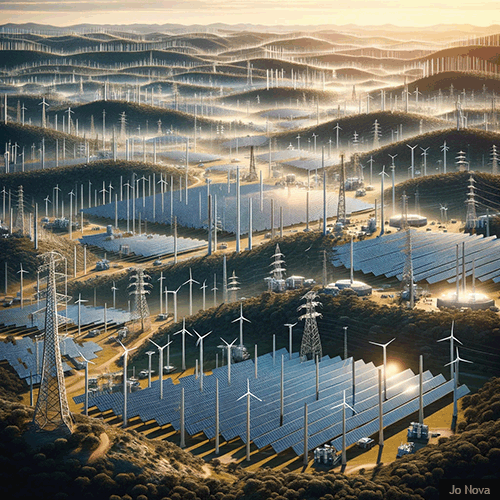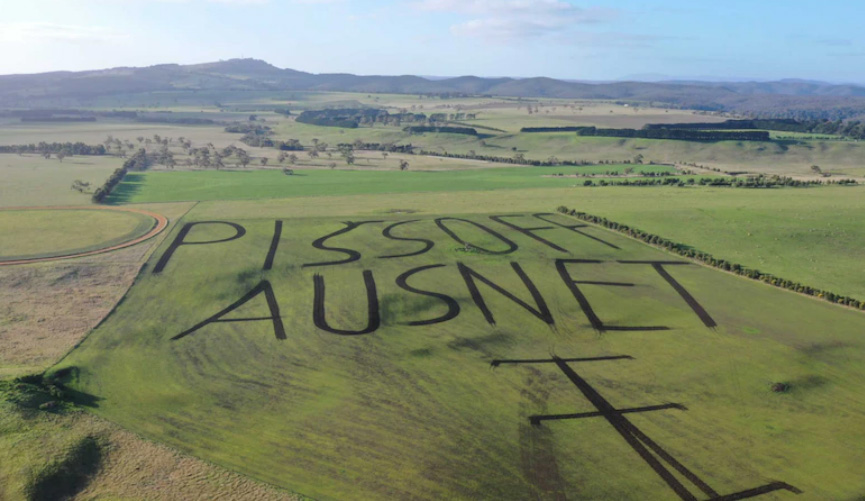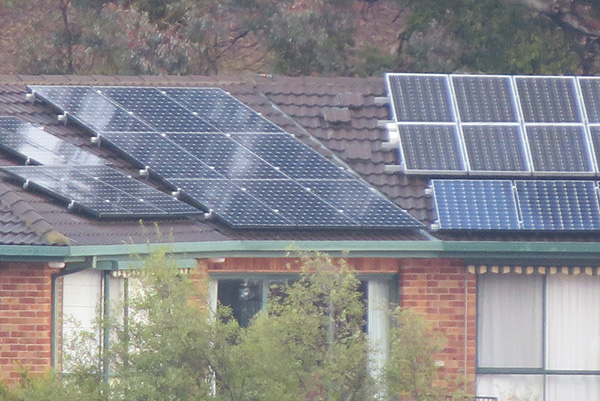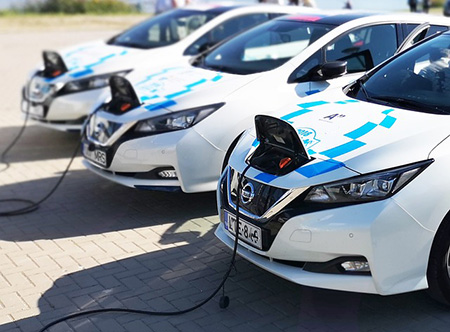
By Jo Nova
The Transmission line cost bomb just went off and it changes everything
This is big. So big the AEMO just announced transmission line costs are up as much as 55%, and they are going to re-visit projects they previously said needed to proceed (which is the nice way of saying they will have to axe some or many of them). What no one is spelling out, is that if the transmission lines can’t be built, they also can’t build the vast solar and wind “farms” that the Labor government was depending on. Suddenly a lot of renewable projects are orphans.
Australia is supposed to build 10,000 kilometers of high voltage transmission lines by 2050. But last week, the AEMO admitted in their Draft 2025 Electricity Network Options Report that these interconnectors would cost between 25 to 55% more than expected, which makes them essentially unaffordable.
Plan B is where they pretend cars, home solar and batteries can save the “Transition”
The old plan of massive wind and solar factories spread across the continent is quietly mutating into a DIY version where the government hopes homeowners will rescue the Net Zero transition by buying the batteries the government and the wind and solar factories can’t afford. What did I say a year ago: “They want you in an EV so they can use your battery to rescue the unreliable grid they built“.
The code word for this is CER or Consumer Energy Resources.
The big question is whether the government can trick enough people into handing over the cash to buy an EV, or a home battery that even with a $4,000 subsidy will barely break even in a best case scenario. What happens when the punters realize the battery they bought to reduce their own costs is being drained by our electricity management at peak hour to keep the grid from crashing?
What happens when the poor realize they are paying more for electricity so rich people can have solar panels and batteries and (slightly) cheaper electricity? Hell to pay.
Now they talk about “social licence”?
The AEMO and renewables fans are also admit the farmers didn’t like them, so the routes had to be redrawn on longer, more difficult paths, and the payments for the pain and inconvenience turned out to be much larger than the inner city latte set expected. Thus and verily, the timelines have also blown out.
The farmer’s pain is referred to as a “social licence” consideration. The farmers, though, don’t mince words:

Western Victorian Farmer
Would the AEMO care so much about social license if they could have forced the lines through? What they are really afraid of is burning off the whole damn country when families everywhere realize they had to pay for $20 thousand million dollars of high voltage lines so renewables factories could make a profit from the subsidies the families also had to pay for too. Professional leaches at 440,000 volts.
There is karma here. Renewables need high voltage lines, but high voltage line installers need cheap reliable energy. Once upon a time, when we had lots of cheap coal power, we might have been able to afford to make the transmission towers that industrial renewables need. But now that the same people who want renewables have banned gas exploration, and destroyed cheap electricity, they can’t possibly afford to build more transmission lines.
Suddenly the AEMO realizes that transmission line costs will hurt consumers. Now they tell us?
They should have seen this coming years ago:
Transmission cost blowout threat to power bills, AEMO warns
By Perry Williams, The Australian
A massive surge in costs to build $20bn worth of electricity transmission would trigger a hit in household power bills, the Australian Energy Market Operator says, amid skill shortages and a battle to win over communities and farmers to the green energy switch.
The cost of overhead transmission line projects has ballooned by up to 55 per cent, with substations rising as much as 35 per cent compared with equivalent estimates provided for AEMO’s 2024 electricity plan.
This is big. So big the AEMO is going to reconsider projects it previously said needed to proceed.
“AEMO recognises that increases in costs for electricity transmission network development would impact bills for electricity consumers,” the operator said. “The 2026 ISP will revisit transmission network projects previously identified as needing to proceed … seeking to ensure that overall costs for consumers are optimised.”

Hence the “Plan B” is to get the consumer to foot the bill:
One area where AEMO may be able to cut back on costs is by leaning more heavily on household sources such as rooftop solar, electric vehicle to grid supplies and batteries which received a recent subsidy boost. Taxpayers will contribute $4000 for an average household battery installation under a $2.3bn election commitment by the Prime Minister, with Labor promising the policy will push electricity prices down for “everyone”.
As Graham Lloyd points out, the power utilities are all warning that shifting the burden to householders is not going to work:
Future of power uncertain and expensive
By Graham Lloyd, The Australian
In April, Transgrid said assumptions that Virtual Power Plants will experience the same level of availability and flexibility to respond to market conditions as an equivalently sized utility-scale battery energy storage system are not reasonable.
Households were unlikely to accept that their assets may be accessed frequently and run very hard because household solar and batteries are primarily investments intended to provide utility and value to consumers rather than the market, Transgrid said.
In March, Queensland power utilities Ergon Energy and Energex gave a similar warning.
“We are cautious of the approach to model customer behaviour based on economically rational models, as we consider most CER investments do not conform to these modelling outcomes,” the utilities said.
“For example, based on our anecdotal experience, AEMO’s assumptions regarding the level of battery energy storage systems uptake supported by Virtual Power Plants may be overstated.”
We know this is the new desperate rescue plan for the doomed transition because even the industry lobby site, Reneweconomy, is working so hard to sell it as “handing power to the people”
Giles Parkinson puts on a brave face, pretending that this is “sailing with the wind” and has been “brewing for a while” (as if it’s not a surprise) but this is a big backflip by the AEMO and it’s not remotely good for all those wind and solar projects.
Even he admits this is a fundamental rethink.
Australia is about to see a step change in its renewable transition strategy
Giles Parkinson, Reneweconomy
One thing that seems certain, however, is that the manner of getting there, and closer to 100 per cent renewables over the following decade, is about to get a fundamental rethink, and it could end up delivering the most significant change to the country’s renewable energy blueprint yet.
The document flags a new focus on using existing local networks for more wind, solar and storage, and on leveraging consumer energy resources – the rooftop solar, household batteries and EVs that will be bought and installed by consumers themselves.
That’s a funny way to phrase it Giles? Killing the business…

It’s a significant move. In the absence of a carbon price, rooftop solar has been the most effective tool in killing the business case for Australia’s aging fleet of dirty fossil fuel generators. But it has created issues of its own, and will remain a wild card for the grid if it can’t be tamed by an army of small batteries.
And who pays for that army of small batteries Giles?
Wait, now you tell us that the best way to reduce costs is with “consumer energy resources”, and it’s supposed to be cheaper for everyone. Why didn’t you say so before…
And the growth of consumer energy resources is possibly the best way to ensure that prices do, as promised, actually fall in the transition from coal to green energy – both for those who own and install them, and those who don’t.
He blames the big bad capitalists — but never acknowledges that it was the stupid socialists who rewrote the market:
The evidence so far is that it hasn’t, mostly because the new assets – wind, solar and especially storage – are largely controlled by the same companies that own and control the coal and gas assets.
Indeed, the socialists make it possible for predatory capitalism to monopolize the market and then they act surprised when it does?
Even Giles Parkinson say it’s an appalling mess:
However the plan is framed, social licence remains absolutely critical. Despite the best efforts of some really good renewable energy developers, it’s been poorly handled.
The worst of it has come in the management of the transmission routes, but a combination of entitled development companies, bloody-minded opposition and some appalling planning regimes have created an appalling mess – highlighted by the latest backflip by the new Queensland state LNP government.
Blame the management indeed. Anything but admit it was always a stupid idea. The renewables fantasy was never going to work. It was a horrible plan to cover the country-side in expensive, intrusive, live infrastructure that ruined views, raised the risk of fires, and got in the way of farming and firefighting. And it was all done in the futile hope of changing the weather.
But rejoice, in part, at least, the protests by farmers and communities are working
The industry is so rattled, they even asked Reneweconomy not to publicize their projects lest the people notice what they want to do:
Little wonder some developers are wary of scrutiny. One even asked Renew Economy last week to stop reporting on projects put in front of the federal government’s EPBC process because of the risks of unwanted scrutiny.
Clearly, we need to watch the EPBC list. Can anyone help identify where these are officially listed? If they don’t want us to see, then I’d like to know…
Image by Nerijus jakimavičius from Pixabay